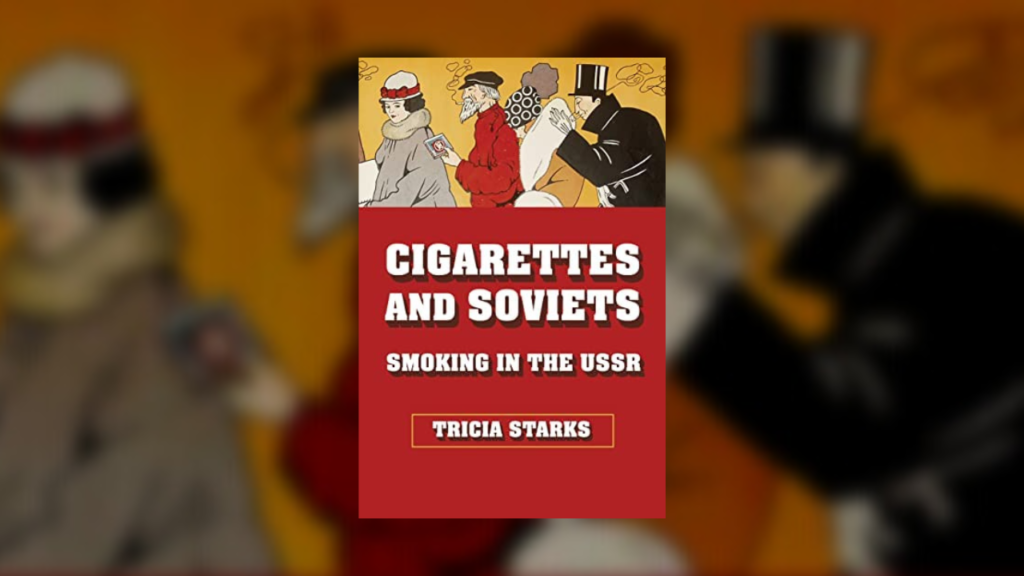by NICK FLORES

Tricia Starks’ Cigarettes and Soviets: Smoking in the USSR (2022) is an exploration into the evolution of a unique industry throughout the course of the former Soviet Union.
Juxtaposed against the development of the cigarette industry in the West, the evolution of tobacco within the USSR provides a looking glass into both the distinctions between the two systems and how they both similarly confronted social pressures. In the author’s words, “[the book] presents the relationship among state, production, profit, health, culture, gender, biology, use, image, and users” (p. 10).
The Cigarette Industry’s Utility in a Nascent Socialist State
Starks begins prior to the Bolshevik Revolution, in 1917, during Lenin and his comrades’ famous train ride back to the then-Russian Empire. She proceeds to move the reader through time by commissioning a theme for the periods that she covers in each chapter, including posters and photographs for reference throughout. The book concludes with the fall of the Soviet Union in 1991 and a brief preview of the transformation of tobacco in the immediate aftermath.
The choice to focus on the tobacco industry through the paradigm of the Soviet system is an interesting case study in what distinguished their socialist system and the particular challenges they faced throughout the 20th century. In the capitalist West, and particularly in the United States, the traditional narrative on the rise of the tobacco industry is one of capitalist marketing and the explosion of consumerism as industrial modes of production expanded throughout the century. However, despite the lack of consumption-driven marketing within the newly formed Soviet republics, the demand for tobacco was tremendous. Soviets initially smoked it in the form of a coarse Russian tobacco known as makhorka or as filterless Russian cigarettes known as papirosy, only later increasing consumption of cigarettes.
Soviet Approach to Health and Cigarettes
Lenin despised the use of tobacco, going as far as to enforce designated smoking areas and issue smoking vouchers during the revolutionaries’ train ride back to Petrograd (p. 1). Following the triumph of the October Revolution, the Soviets would go on to found the first national prophylactic [preventative] healthcare system in 1918 (p. 2). Under the leadership of Nikolai Aleksandrovich Semashko, the new People’s Commissariat for Public Health (known as the Narkomzdrav) quickly acknowledged the dangers of smoking and launched the world’s first mass anti-smoking campaign, calling for both wide-reaching public education and curtailment of production and distribution. However, the conditions that the USSR’s planned economy faced presented them with a difficult choice. That was because demand for tobacco far exceeded supply coming out of the destruction of World War I and the Bolshevik Revolution, the industry’s unions were strong, and the revenue from its sale and export was badly needed. Thus, they decided to continue production while committing to a robust propaganda campaign to inform the public about the dangers of smoking.
The perspective that the public awareness campaigns took serves as a great example of what distinguished the Soviet approach from the West. Representative of the collectivism that guided the state, posters and resources throughout the period highlighted individuals’ responsibility to their community and the social impacts of smoking. While the extent of tobacco’s danger to physical health was far from fully understood, the socialist perspective of Soviet medical professionals led them to include the social implications of smoking in their understanding of its dangers. At a delicate time for the revolutionary project, Narkomzdrav rightfully warned smoking could not only limit one’s ability to be a productive member of society, but could also drain badly needed resources from the state. Posters highlighted how smokers caused fires in factories and in homes, polluted public and personal spaces, and influenced the next generation to take up the habit.
An Unusual Analysis of Former USSR
The focus of Cigarettes and Soviets is enticing. Starks’ avoidance of Cold War-era pseudo-history and histrionic oversimplifications, which seek to disparage the Soviet project, is particularly refreshing. Starks notes:
“The depiction of tobacco as the true opiate of the masses assumes a passive smoking population and a state in total control. The potency and popularity of papirosy prepared the Soviets to have a massive market for any tobacco they produced, and for the state to interfere in the biopsychosocial bond between smoker and tobacco held danger (p. 8).”
Toward Freedom for more